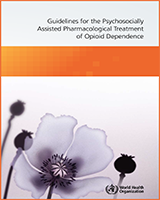| | Strength of recommendation | Quality of evidence |
|---|
| Choice of treatment | For the pharmacological treatment of opioid dependence, clinicians should offer opioid withdrawal, opioid agonist maintenance and opioid antagonist (naltrexone) treatment, but most patients should be advised to use opioid agonist maintenance treatment. | Strong | Low to moderate |
|---|
| For opioid-dependent patients not commencing opioid agonist maintenance treatment, consider antagonist pharmacotherapy using naltrexone following the completion of opioid withdrawal. | Standard | Low |
|---|
| Opioid agonist maintenance treatment | For opioid agonist maintenance treatment, most patients should be advised to use methadone in adequate doses in preference to buprenorphine. | Strong | High |
|---|
| During methadone induction, the initial daily dose should depend on the level of neuroadaptation; it should generally not be more than 20 mg, and certainly not more than 30mg. | Strong | Very low |
|---|
| On average, methadone maintenance doses should be in the range of 60–120 mg per day. | Strong | low |
|---|
| Average buprenorphine maintenance doses should be at least 8 mg per day. | Standard | Very low |
|---|
| Methadone and buprenorphine doses should be directly supervised in the early phase of treatment. | Strong | Very low |
|---|
| Take-away doses may be provided for patients when the benefits of reduced frequency of attendance are considered to outweigh the risk of diversion, subject to regular review. | Standard | Very low |
|---|
| Psychosocial support should be offered routinely in association with pharmacological treatment for opioid dependence. | Strong | High |
|---|
| Management of opioid withdrawal | For the management of opioid withdrawal, tapered doses of opioid agonists should generally be used, although alpha-2 adrenergic agonists may also be used. | Standard | Moderate |
|---|
| Clinicians should not routinely use the combination of opioid antagonists and minimal sedation in the management of opioid withdrawal. | Standard | Very low |
|---|
| Clinicians should not use the combination of opioid antagonists with heavy sedation in the management of opioid withdrawal. | Strong | low |
|---|
| Psychosocial services should be routinely offered in combination with pharmacological treatment of opioid withdrawal. | Standard | Moderate |
|---|
| Pregnancy | Opioid agonist maintenance treatment should be used for the treatment of opioid dependence in pregnancy. | Strong | Very low |
|---|
| Methadone maintenance should be used in pregnancy in preference to buprenorphine maintenance for the treatment of opioid dependence; although there is less evidence about the safety of buprenorphine, it might also be offered. | Standard | Very low |
|---|
